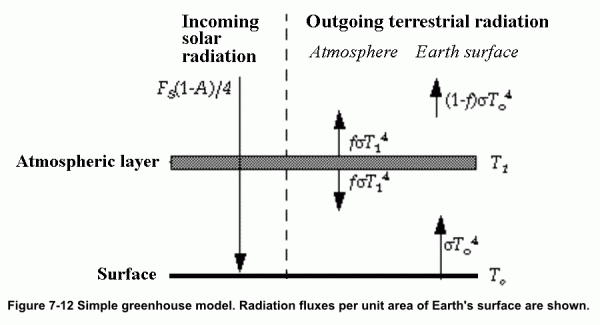https://www.bookwormroom.com/2021/02/18/simple-greenhouse-model-2-the-reckoning/

Simple Greenhouse Model 2: The Reckoning
The simple Greenhouse Effect model is a door to understanding complex Earth Energy Budgets and the false claims of CO2 Alarmists
Previously, I looked at a tutorial model of the Earth’s greenhouse effect, like this one from Harvard University.
My focus the last time was that “watts” refer to an energy rate, so if 240 Joules per second are being spent (exiting to space) while 240 Joules per second are being earned (absorbed), there’s no room for a thermal savings account. The notion that gases like CO2 “trap heat” is therefore a myth.
This time the focus is on Radiative Forcing. The model alleges that surface heat excites the atmospheric layer, which then excites the surface. This means that the two bodies are thermally coupled. If this is the case, however, then the now-warmer surface should warm the layer even more, and we’d expect to see something like this.
The thermally coupled layer heats the surface, which heats the layer, which heats the surface, and so on.
Yet this does not occur in the model: After a single stroke of added warmth, communication ceases. This calls into question whether such an interaction can occur in the first place. To settle that question, go to Engineering Toolbox, scroll down to the Radiation Heat Transfer Calculator, enter the same temperature in both boxes, press Calculate, and see how many watts the “hot” one radiates to the “cold” one. I’ll wait.
As you see, two radiations from two equally heated bodies do not combine; they cancel out instead.
Ah, you may say, but that’s why the simple model is flawed: complex models avoid such an error.
Well no, complex models plow right into it.
Here I’ve inserted Celsius temperatures beside a few of the radiant fluxes marked on a complex greenhouse model. (To verify these temperatures, you can go to Science Facts – Temperature Conversions, set Albedo to 0, and enter any listed flux.)
The bottom left of the chart shows that the surface falls to 64 W/m² (note the up arrows) after initially gaining 161. The bottom right shows what happens when 333 is added to 64: 397. Nearly 1 watt is diverted, so the surface now radiates 396 at 16 degrees. This is radiative forcing, i.e., mindless addition, at work.
To those who insist that a 4° body can heat a cooler body to 16°, what more can I say?
To the rest, here’s a take-home lesson:
- The purpose of the tutorial model is to convince initiates that radiative heat transfer is accomplished by addition. But two cold things do not make a hot.
- Radiated heat is transferred by difference. Simply put, a receptive 80 watt object exposed to 100 watts will absorb another 20 watts, max. It will not attain 180 watts.
- Since radiative forcing – the addition of opposing fluxes – is a fiction, and since this is greenhouse theory’s central tenet, greenhouse theory is a false paradigm.






